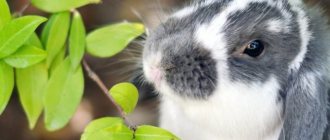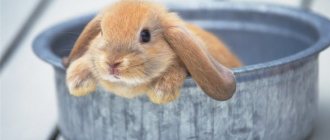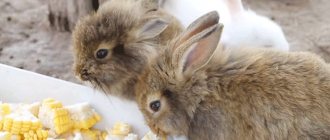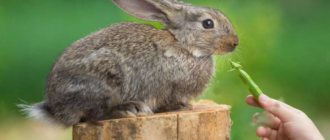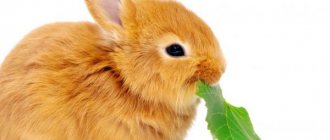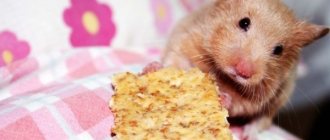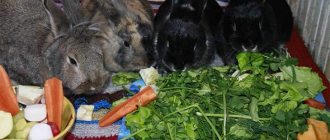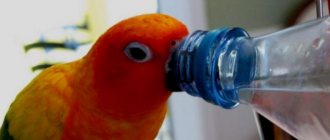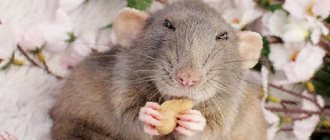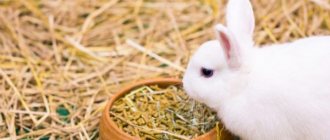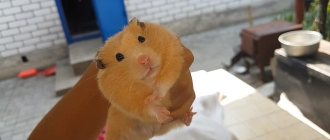Expert opinion
Dobryshev Sergey Anatolievich
Professional rabbit breeder and hare breeder with 30 years of experience
In order for rabbits to grow healthy and gain weight well, they need adequate nutrition. It is difficult to overestimate the role of grain included in their diet. The value of cereals, which are classified as concentrated feed, lies in their nutritional value, as well as the high content of proteins, carbohydrates, vitamins and microelements.
Another advantage is the economic availability of this type of food. However, not all grains are equally beneficial for rabbits. Therefore, it is necessary to study what grain to feed rabbits, at what period of their life and in what quantity.
Digestive system of rabbits
The animals eat coarse food with the help of their incisors, and they crush it with their molars. After exposure to saliva, food becomes soft and is safely sent down the esophagus directly to the stomach.
The musculature of the walls of the monocavitary stomach of rabbits is thin and flabby. This guarantees the absence of gag reflexes in animals. But there is also a negative side - if a rabbit eats something inappropriate for itself, its stomach will stop functioning, which can lead to unpleasant consequences, including death.
The size of the internal organs also has its own peculiarity. Swallowed food reaches the duodenum, which is twelve centimeters long, only in a period of time from one hour to seven hours. An underdeveloped intestine does not have peristalsis, which would take on the function of moving food into the stomach.
Only a new portion of it pushes through the swallowed food. Therefore, rabbits should receive food, including grain products, frequently. Pets should always have food in their feeder; starvation is unacceptable for them.
You can read about the features of feeding pregnant rabbits in our article.
Poisonous plants
There are a number of plants that are deadly to rabbits and should not be given to them under any circumstances. It is also necessary to ensure that they do not get into the hay, since not all lose their toxic properties when dried. So, here's what grass you shouldn't give to rabbits:
- celandine (dangerous in any quantity, especially milky juice; remains toxic when dried);
- milkweed (it is important to know well what real milkweed looks like - many other plants produce milkweed when scrapped);
- buttercup;
- swamp whitewing;
- hemlock;
- horned cornflower;
- vekh poisonous;
- hellebore;
- meadow lumbago (sleep-grass);
- dope;
- belladonna;
- black root;
- anemone (anemone);
- wrestler (wolfsbane);
- autumn crocus (winter meadow);
- digitalis;
- marsh marigold;
- Avran officinalis;
- cockle
Important: if you cannot accurately determine the type of grass by appearance, it is better to be safe and do not give it to rabbits.
Hint: Poisonous plants often prefer partial shade, shade, and swampy areas. In these places you should avoid collecting grass and making hay.
Benefits of Grain Feeding
Grains go well with the rabbits' digestive system. They are able to push through previously eaten food well.
The grain is well digested by the digestive system of rodents. The availability of grain for rabbits is of particular importance in winter, when it is not possible to feed them fresh grass. The most important grain crops for feeding rabbits are wheat, oats and barley. Corn can also be counted among them.
Animals eat them with great appetite, and purchasing this type of grain is not a big problem for rabbit breeders. Each type contains its own set of valuable nutrients, so rabbits should include all of these varieties in their diet.
Please note that feeding rabbits exclusively with grain is unacceptable. In summer, the diet must include fresh grass, vegetables and fruits, and in winter, hay prepared for future use. Compound feed that has a balanced composition is widely used.
When feeding only greens and vegetables, it will be impossible to achieve rapid weight gain in rabbits, which is especially important when raising meat breeds. Easily digestible grain makes the diet complete and prevents gastrointestinal diseases.
Another advantage of grain crops is that they do not spoil, so they can completely fill the feeder.
Grain mixture recipe from Fyodor Anikeev.
Experienced rabbit breeder Fyodor Anikeev has many years of experience in breeding rabbits. He experiments a lot with methods of feeding animals, constantly striving to improve the yield of feed. At the same time, we always strive to use those components that are currently most accessible and attractive in price. Of course, not to the detriment of the common cause. As an example, I give one of the options for winter feeding rabbits. All values are indicated as percentages:
- Grain (corn, wheat, barley) 50%
- Herbal (hay) flour 15%
- Beet pulp 15%
- Soybean extruded or calcined 4%
- Sunflower cake 14%
- Meat and bone meal 1%
- Bone meal 0.3%
- chalk 0.3%
- salt 0.4%
Which grain to choose
Wheat
Nutritious cereal has a positive effect on the health of rodents. During the growth period, wheat promotes rapid weight gain. It contains a large amount of proteins, carbohydrates, fats, vitamins B and E.
Wheat has a high nutritional value, so there is a limitation - its amount should not exceed 25-30% of the total amount of feed given. Increased consumption of wheat will increase the formation of gluten in the stomach, which can cause bloating and metabolic disorders.
Oats
This cereal contains a large amount of pantothenic acid, which keeps rabbits' bodies in good shape. It also helps to improve the reproductive function of animals. Oats are a natural antioxidant, so it is advisable to include them in grain mixtures so that the body can cleanse itself of toxins.
Despite the fact that oats have a high calorie content, they do not cause obesity in rabbits, so they can make up 50% of the total composition of the food given.
Oats contain proteins, fats, and carbohydrates. It also contains zinc, manganese, copper, cobalt, vitamins B1, B5, B6. This culture is the best option for feeding rabbits.
Barley
Barley is a more nutritious cereal crop than oats. It is very beneficial for the digestive system of rabbits. Barley is recommended to be given to nursing rabbits and young animals in need of increased nutrition. It also promotes rapid weight gain.
Substances such as lysine and choline found in barley improve the overall well-being of animals. Barley grains also contain potassium, calcium and B vitamins. The outer shell of the grains is difficult for the stomach of rodents to digest, so it is recommended to remove it by grinding before feeding.
Barley should be limited during the period when rabbits are being prepared for mating. The nutritious product can lead to obesity, which will negatively affect the state of reproductive function.
Corn
This cereal is not high in calories. Corn contains large quantities of carbohydrates, carotene, phosphorus, potassium, magnesium, iron, vitamins E, B1, B2, PP.
However, protein and calcium are contained in this cereal in limited quantities. Long-term feeding of corn is not recommended as it can cause unwanted obesity in rabbits.
Nutritional value of rye and its feed value
Rye has average nutritional value, because the grain crop is 0.18 kg of feed units (k.u.). This is an indicator that allows you to determine the nutritional value of crops. 1 k.e. is equal to the calorie content of 1 kg of dry fodder oats or 1414 kcal.
For 1 k.e., about 5.6 kg of rye feed is required. The energy and nutritional value of 100 g of rye is as follows:
- water - 12%, while dry matter - 88%;
- 10.1 g protein, 2.3 g fat and 57.8 g carbohydrates;
- complex carbohydrates represented by fiber (3 g) and starch (54.8 g);
- calorie content - 287 kcal;
- minerals beneficial for pets: zinc (2.04 mg), copper (460 mcg), etc.;
- amino acids - lysine, methionine, threonine, tryptophan.
Despite the presence of amino acids in the product, none of them are absorbed by the animal body. Therefore, in order to provide livestock with all the necessary nutrients, the diet is supplemented with other cereal crops. They also compensate for the lack of amino acids with special supplements containing lysine, threonine, methionine and tryptophan.
Reference. The rye should rest. Grain crops should not be given to animals immediately after harvest.
Rules for feeding grains
Cereals are very useful for feeding rabbits, but it is necessary to regulate their intake by rodents. Feeding rabbits with grain requires compliance with certain rules.
Pre-processing the grains will improve digestion and allow for better absorption of nutrients. The most commonly used methods include crushing, sprouting, steaming and yeasting.
Expert opinion
Dobryshev Sergey Anatolievich
Professional rabbit breeder and hare breeder with 30 years of experience
IMPORTANT! When introducing grain crops into the diet of rabbits, a constant supply of fresh water must be ensured.
Before purchasing a product, a visual inspection is necessary - the grains must be clean and have the correct shape. There should be no oily film on the surface.
Why should rye be limited in animal diets?
Rye grains are distinguished by a high content of non-starchy polysaccharides (complex carbohydrates), among which pentosan stands out. This substance is difficult to digest , so young animals are given rye along with enzymes. These are enzymes that break down complex carbohydrates into simpler compounds.
Hybrids of cereal crops developed as a result of selection are vulnerable to fungal diseases. Ergot often appears on them. Infected rye is harmful to laying hens, pregnant females and young animals. It is important to ensure that the maximum amount of cereal per 1 kg of feed mixture does not exceed 1 g.
Despite its low resistance to fungal diseases, rye contains fewer toxic compounds compared to other crops. It contains practically no zearalenone and deoxynivalenol.
If the share of grain crops in the liquid diet is more than 1/3, the animals begin to develop increased foaming. The cause of bubbles in saliva is soluble proteins. To eliminate them, oil is introduced into the diet.
Grain crushing
It is convenient to use a grain crusher to crush grain. You can buy it in a store or make it yourself.
To carry out the process at home, you should purchase a household-type grain crusher. The use of this technique will significantly simplify the process of preparing grain for feeding rabbits.
When choosing a grain crusher, you need to take into account productivity, grinding degree, power, manufacturer and price. You can make your own grain crusher from a grinder.
Germination
Sprouted grain is eaten by rabbits with great pleasure and is well absorbed by them. When germinated, the nutritional value of the grain increases.
The germination process consists of the following stages:
- Rinse the grain with warm water. The amount of grain depends on the need.
- Collect empty shells that float to the surface and discard them.
- Prepare a container for germination. Boxes, baking sheets, and pallets can be used as them.
- Pre-soak the grain to swell with a small amount of water and place it in a warm place for a day.
- Remove excess moisture.
- Place the swollen grains in germination containers on a thin, moistened layer of soil.
After a few days, small sprouts will appear, which can be used to supplement animal food.
DIY greens
To diversify the diet of livestock, professionals use fresh grass. But what can you do in winter when you don't have access to an important element of your diet? In this case, it is better to grow tasty food from grain.
The hydroponics method allows you to obtain juicy greens from cereals. The first step is to disinfect the raw materials using a quartz lamp. Radiation kills fungi and diseases that may be on the surface of the crop. Then pour it into a container, fill it with water and leave it in a cool room for a day to swell.
The finished material is laid out on pallets with sides. It should be remembered that the layer should not exceed 2 cm, otherwise there will be a problem with pecking. Cover the top with a rough cloth and spray with water from a spray bottle. The containers are left for 3 days at a temperature of 24°C. To prevent drying out, the burlap is irrigated with liquid once a day.
The sprouted grain is moved closer to natural light. For a week, water with a special hydroponic solution:
- water - 20 l;
- wood ash - 1 kg;
- ammonium nitrate - 200 g;
- boric acid - 0.7 g;
- copper sulfate - 0.01 g;
- manganese sulfate - 0.4 g.
The liquid is mixed with ash, boiled and filtered through thick gauze. Then the remaining chemicals are added, thoroughly dissolved and packaged in glass jars. For one bucket of water you need 200 ml of solution. This substance is watered over cereals twice a day. From one pallet you can grow enough greens for your entire livestock
Steaming
To steam the grain, it is necessary to place it in a large container not to the brim, taking into account its swelling. Pour boiling water so that the water is 5-10 centimeters above the grains. Add salt at the rate of one tablespoon per bucket and stir. To cover with a lid. The food will be ready in 5-6 hours after infusion in the saline solution.
Alternative to fresh grass
Any replacement for green food for rabbits is relative: it is better to achieve maximum diversity of the diet, taking into account the season. Of the above, special granulated feeds are the most convenient: they include everything or almost everything you need.
- hay;
- haylage;
- branches of coniferous and deciduous trees, shrubs;
- hay or grass flour;
- sex;
- straw (in extreme cases, since it has little nutritional value).
- cereals;
- legumes;
- compound feed (especially for rabbits or other domestic animals, but not for poultry!).
Vitamin premixes, supplements, fish oil.
Food waste (porridge, bread, washed vegetable peelings).
Important! Rabbits are very sensitive to the quality of any food. Rot, mold, dirt, getting wet or freezing - all this must be excluded without fail.
Take care of the quality of food for your pets - and they will respond to you with excellent health, fertility, and excellent weight gain.
Source
Yeasting
To quickly gain weight in a rabbit, it is recommended to feed grain prepared by yeast. To carry out this process you need:
- grind grain;
- Dissolve nutritional yeast in clean water;
- Fill the container with grain with warm water;
- add yeast solution at the rate of 36 grams of yeast per two liters of water;
- stir and leave to ferment.
The fermentation process takes from six to nine hours. During this period, it is necessary to constantly stir the mixture. Rabbits are fed by adding grain that has been fermented to the total mass of feed, 2-3 tablespoons per serving.
Cooking methods
There are differences among rabbit breeders regarding the form in which healthy food should be offered to the animal. Some are of the opinion that any grains should be offered to animals exclusively in dry form. Others believe that the biologically active substances contained in cereals best reveal their beneficial qualities when steamed. Most likely, the one who rationally approaches the organization of rabbit nutrition, including both dry and steamed grain substrate, will be right.
Yeasting
To speed up weight gain, experts recommend feeding young rabbits with the so-called yeast batch. There are three ways to prepare this rabbit dish:
- sponge;
- unpaired;
- sourdough
Sponge yeast batch is prepared using regular yeast. For 10 kg of feed you will need to take 500 g of yeast and 25 liters of warm water. In an enamel pan, grain and water are mixed together, into which yeast is gradually introduced in equal portions. Once every 30 min. the mixture must be thoroughly mixed. It takes about 6 hours to prepare the dough.
Note! When the dough is ready, add the second part of the feed and warm water. The mixture will be ready for use after 3 hours.
A straight yeast batch takes 9 hours to prepare. It requires grain, nutritional yeast and warm water. For 25 kg of grain you need to take 300 g of yeast and 30 liters of water. The ingredients are mixed in a vat or enamel pan. The mixture must be stirred every 30 minutes. throughout the entire cooking process.
To prepare a starter batch, you need to have a supply of malt or malted feed, yeast and water. The proportions are as follows: malted food - 10 kg, yeast - 500 g, water - 10 l. The batch will be ready in about 6 hours. Next, you should divide the resulting substrate into 2 parts. One part should be used to prepare a new starter, adding more malt, yeast and water, and the other part should be sent for yeasting, adding food.
It is important for a rabbit breeder to be able to independently prepare a grain mixture for a pet.
Steaming
Steaming is the easiest way to prepare grain for rabbits. It is carried out as follows:
- Pour the grain mixture into a vat or pan.
- Salt well, but do not oversalt.
- Mix well.
- Cover with a lid and leave for 5-6 hours.
Germination
The nutritional value of the sprouted grain increases several times, as all the beneficial substances that ensure the growth of the stem are activated. The germination process is carried out according to the following scheme:
- Rinse the grain in warm water several times.
- Those grains that float to the surface must be caught with a slotted spoon and discarded.
- Place the grains in an enamel pan.
- Place the pan in a dark place.
How to feed grain mixtures to rabbits
Rabbits can be offered either each type separately or mixtures of them. This is reasonable, since each type of grain crop contains a certain set of nutrients, vitamins and minerals. When feeding with formulas, nutrition will become more balanced. It is also recommended to add bran to the mixture.
When preparing mixtures, it is necessary to take into account the age of the rabbits and their physical condition. For adult individuals, the following ratio is suitable: oats - 40%, wheat and barley - 20% each, corn and bran - 10% each.
When feeding meat rabbits, the proportion of barley should be increased to 40%, wheat – 20%, corn and oats – 15% each, and the remaining 10% should be left for bran. During the period of their accelerated growth, young animals should be offered a grain mixture in the following proportions: oats and corn - 30% each, barley and bran - 15% each, wheat - 10%.
These recommendations are indicative and can be adjusted by rabbit breeders. The inclusion of grain mixtures in animal diets depends on the season. This becomes most important in winter, when there is no possibility of feeding animals with fresh herbs.
Feed mixture for winter
In winter, when the animal’s body requires food with increased nutritional characteristics, it is advisable to prepare a grain feed mixture. For each age group, its own nutritional substance is prepared. So, for young rabbits, the percentage of cereals is as follows: barley - 15%, millet - 10%, corn grains - 30%, oats - 30%, bran - 15%. For adult rabbits, the feed mixture is prepared in the following proportions: barley - 20%, millet - 20%, corn grains - 10%, oats - 40%, bran - 10%.
Important! If the rabbit lives outdoors, the proportion of barley in the feed mixture increases by 10-15%.
Zolotukhin method for feeding rabbits
The famous rabbit breeder has extensive experience in successfully raising rabbits, which he willingly shares with everyone. He offers the following scheme for feeding rabbits with grain crops:
- Little rabbits who are just beginning to get used to adult food after a period of milk feeding are given brewed oats.
- After some time, crushed oats begin to be added to food in small portions.
- After reaching the age of four months, the young animals begin to be given crushed corn.
- Rabbits should be given whole oats during the period of feeding their young rabbits with milk.
- Crushed barley should be given to rabbits before mating, as well as to pregnant rabbits before the imminent birth.
- After six months of age, males should be given a mixture of oats, barley and a small amount of corn.
If you follow the rules proposed by Zolotukhin, you can get healthy and well-fed rabbits.
